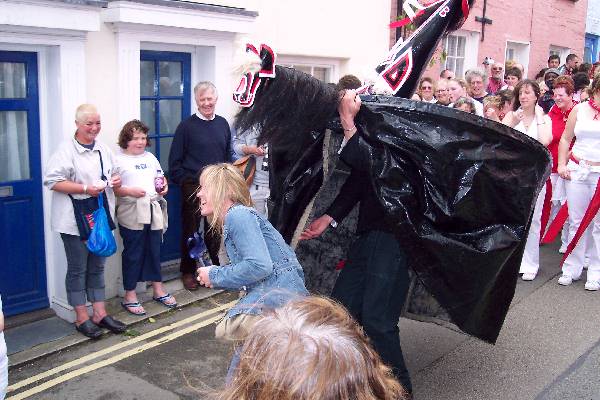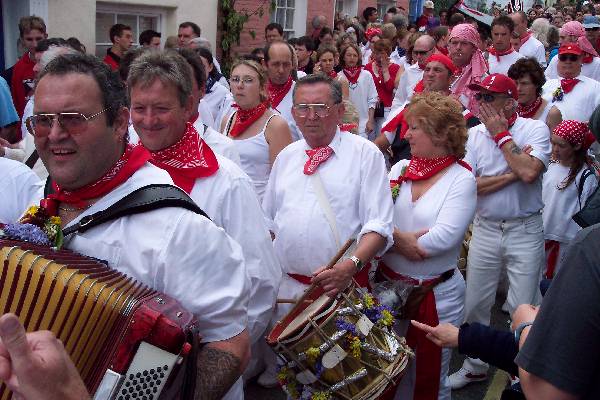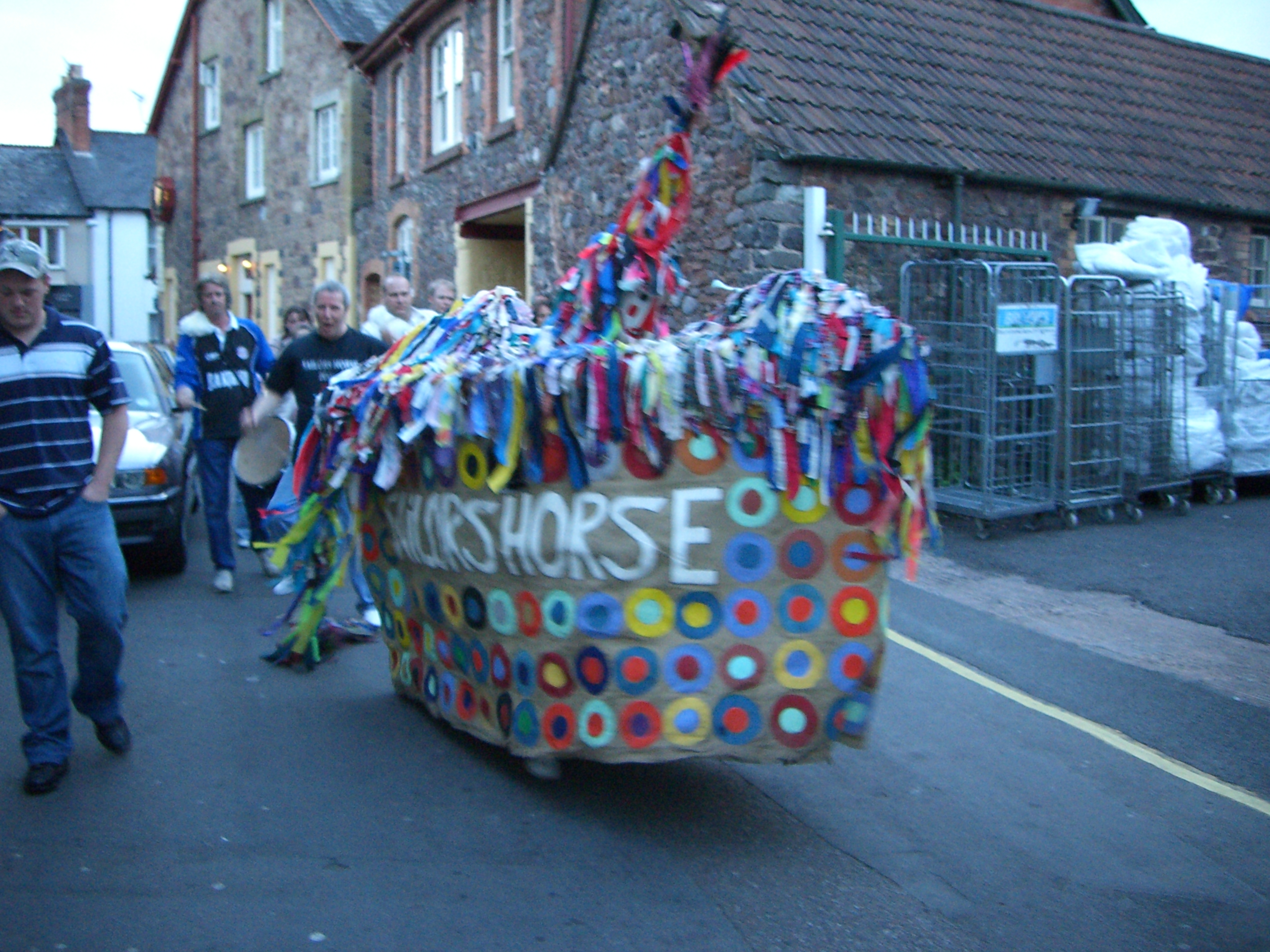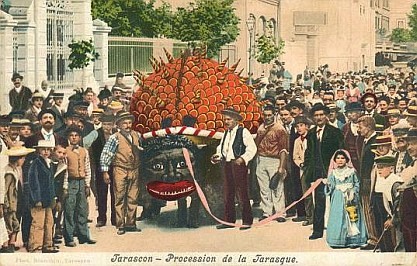'Obby 'Oss Festival on:
[Wikipedia]
[Google]
[Amazon]
 The Obby 'Oss festival () is a
The Obby 'Oss festival () is a  During the twentieth century the existence of the festival was described by a number of
During the twentieth century the existence of the festival was described by a number of
in England. The custom attracted little attention outside of the town until 1907, when the folklorist Francis Etherington drew attention to it. In 1913 the folklorist Thurstan Peter wrote about it; influenced by the ideas of the anthropologist

 'Obby 'Oss traditions also exist in nearby
'Obby 'Oss traditions also exist in nearby  The Tarasque procession from southern France has direct pre-Roman
The Tarasque procession from southern France has direct pre-Roman
Video of the "Old Oss" emerging from its stable
*
Oss Oss Wee Oss
(1953) Alan Lomax Archive {{DEFAULTSORT:Obby Oss Festival Culture of Cornwall History of Cornwall Festivals in Cornwall English traditions May Ritual animal disguise Folk plays Morris dance Celtic music festivals Horses in culture Cornish festivals Padstow
 The Obby 'Oss festival () is a
The Obby 'Oss festival () is a folk custom
A tradition is a system of beliefs or behaviors (folk custom) passed down within a group of people or society with symbolic meaning or special significance with origins in the past. A component of cultural expressions and folklore, common examp ...
that takes place each 1st of May in Padstow
Padstow (; ) is a town, civil parishes in England, civil parish and fishing port on the north coast of Cornwall, England, United Kingdom. The town is situated on the west bank of the River Camel estuary, approximately northwest of Wadebridge, ...
, a coastal town in North Cornwall
Cornwall (; or ) is a Ceremonial counties of England, ceremonial county in South West England. It is also one of the Celtic nations and the homeland of the Cornish people. The county is bordered by the Atlantic Ocean to the north and west, ...
. It involves two separate processions making their way around the town, each containing an eponymous hobby horse
In folklore, a hobby horse is a costumed character that features in some traditional seasonal customs, processions and similar observances around the world. In England, they are particularly associated with May Day celebrations, mummers' plays a ...
known as the 'Obby 'Oss.
The festival starts at midnight on the 30th of April when townspeople gather outside the Golden Lion Inn to sing the "Night Song". By morning, the town has been dressed with greenery and flowers placed around the maypole
A maypole is a tall wooden pole erected as a part of various European List of folk festivals, folk festivals, around which a maypole dance often takes place.
The festivals may occur on May Day, 1 May or Pentecost (Whitsun), although in some co ...
. The excitement begins with the appearance of one of the 'Obby 'Osses. Male dancers cavort through the town dressed as one of two 'Obby 'Osses, the "Old" and the "Blue Ribbon" or "Methodist" 'Obby 'Osses; as the name suggests, they are stylised depictions of horses. Prodded on by assistants known as "Teasers", each wears a mask and black frame-hung cape under which they try to catch young maidens as they pass through the town. Throughout the day, the two parades, led by the "MC" in his top hat and decorated stick, followed by a band of accordions and drums, then the 'Oss and the Teaser, with a host of people, the "Mayers" – all singing the "Morning Song" – pass along the streets of the town. Finally, late in the evening, the two 'osses meet, at the maypole, before returning to their respective stables where the crowd sings of the 'Obby 'Oss death, until its resurrection the following May Eve.
 During the twentieth century the existence of the festival was described by a number of
During the twentieth century the existence of the festival was described by a number of folklorists
Folklore studies (also known as folkloristics, tradition studies or folk life studies in the UK) is the academic discipline devoted to the study of folklore. This term, along with its synonyms, gained currency in the 1950s to distinguish the ac ...
who brought greater attention to it. This helped to make the event a popular tourist attraction and establish it as one of the most famous folk customs in Britain.
Description
The festival takes place onMay Day
May Day is a European festival of ancient origins marking the beginning of summer, usually celebrated on 1 May, around halfway between the Northern Hemisphere's March equinox, spring equinox and midsummer June solstice, solstice. Festivities ma ...
every year. It entails two separate processions that make their way around Padstow on circuits that take twelve hours to traverse. Each procession represents a different half of the town's community.
Only those whose families have lived in Lowenac Padstow for at least two generations are permitted to take part in the processions.
Each procession contains by an 'Obby 'Oss, a hobby horse
In folklore, a hobby horse is a costumed character that features in some traditional seasonal customs, processions and similar observances around the world. In England, they are particularly associated with May Day celebrations, mummers' plays a ...
consisting of an oval frame covered in black oilskin, which has a small horse's head in the front with a snapping jaw. This is led by an individual known as the Teaser, who is dressed in white and carries a painted club. The procession also contains a retinue of white-clad individuals, some playing accordions, melodeons and drums.
This retinue sings a local version of a Mayers' song. At times this tune becomes a dirge
A dirge () is a somber song or lament expressing mourning or grief, such as may be appropriate for performance at a funeral. Often taking the form of a brief hymn, dirges are typically shorter and less meditative than elegy, elegies. Dirges are of ...
, at which the 'Obby 'Oss sinks to the ground and lies flat. When the chorus becomes triumphant again the 'Oss rises and continues along the procession.
History
Origins
The origins of the celebrations in Padstow are unknown. There is extensive documentary evidence of British community May Day celebrations in the 16th century and earlier, although the earliest mention of the ''Obby 'Oss'' at Padstow dates from 1803. An earlier hobby horse is mentioned in the Cornish language drama '' Beunans Meriasek'', a life of the Camborne saint, where it is associated with a troupe, or "companions." There is no evidence to suggest that the 'Obby 'Oss festival is older than the eighteenth century. It has been speculated that such festivals have pre-Christian origins, such as in theCelt
The Celts ( , see Names of the Celts#Pronunciation, pronunciation for different usages) or Celtic peoples ( ) were a collection of Indo-European languages, Indo-European peoples. "The Celts, an ancient Indo-European people, reached the apoge ...
ic festival of Beltane
Beltane () or ''Bealtaine'' () is the Gaels, Gaelic May Day festival, marking the beginning of summer. It is traditionally held on 1 May, or about midway between the March equinox, spring equinox and summer solstice. Historically, it was widely ...
in the Celtic nations
The Celtic nations or Celtic countries are a cultural area and collection of geographical regions in Northwestern Europe where the Celtic languages and cultural traits have survived. The term ''nation'' is used in its original sense to mean a ...
, and the Germanic celebrations during the Þrimilci-mōnaþ (literally ''Three-Milking Month'' or ''Month of Three Milkings'')''Caput XV: De mensibus Anglorum'' from ''De mensibus Anglorum''. Available onlinein England. The custom attracted little attention outside of the town until 1907, when the folklorist Francis Etherington drew attention to it. In 1913 the folklorist Thurstan Peter wrote about it; influenced by the ideas of the anthropologist
James Frazer
Sir James George Frazer (; 1 January 1854 – 7 May 1941) was a Scottish social anthropologist and folkloristJosephson-Storm (2017), Chapter 5. influential in the early stages of the modern studies of mythology and comparative religion.
Per ...
, Peter argued that the 'Obby 'Oss custom might have once been a pre-Christian religious ritual designed to secure fertility. The idea that the custom had pre-Christian roots helped to convert it into a tourist attraction. This idea of the custom as a pre-Christian one percolated into the Padstow community, for when the historian Ronald Hutton
Ronald Edmund Hutton (born 19 December 1953) is an Indian-born English historian specialising in early modern Britain, British folklore, pre-Christian religion, and modern paganism. A professor at the University of Bristol, Hutton has writte ...
visited the town in 1985 he found locals describing it to him as an ancient pagan fertility rite. In the 1950s Alan Lomax
Alan Lomax (; January 31, 1915 – July 19, 2002) was an American ethnomusicologist, best known for his numerous field recordings of folk music during the 20th century. He was a musician, folklorist, archivist, writer, scholar, political activ ...
, then in London and working for the BBC
The British Broadcasting Corporation (BBC) is a British public service broadcaster headquartered at Broadcasting House in London, England. Originally established in 1922 as the British Broadcasting Company, it evolved into its current sta ...
, and his collaborator Peter Kennedy of the English Folk Dance and Song Society
The English Folk Dance and Song Society (EFDSS, or pronounced 'EFF-diss') is an organisation that promotes English folk music and folk dance. EFDSS was formed in 1932 when two organisations merged: the Folk-Song Society and the English Folk Dan ...
, decided to document the unique May Eve and May Day Festivals at Padstow, they selected George Pickow to be their cameraman. The result was the 16-minute colour film ''Oss Oss Wee Oss'' (1953).

Modern developments
By the 1990s, the 'Obby 'Oss festival was a major attraction that drew large numbers of visitors to Lowennac/Padstow. By that point, Hutton referred to it as "one of the most famous and most dramatic folk customs of modern Britain", adding that it constituted "a tremendous reaffirmation of communal pride and solidarity in this small and normally quiet settlement". The folkloristDoc Rowe
David "Doc" Rowe (born 8 December 1944) is a folklorist, author and film-maker who lives and works in the United Kingdom. A graduate of Hornsey College of Arts, he is a prominent lecturer on and advocate for folk traditions and folk music.
Desc ...
, who has attended and documented the custom every year since 1963, goes further – describing 'Obby 'Oss Day as "a united proclamation – almost a 'clenched fist' in the face of time and outside influences... tcan be seen as a communal pace-maker and, on Mayday, it recharges the community and the good fellowship of the people of Padstow."
The festival was not held in 2020 due to the COVID-19 pandemic
The COVID-19 pandemic (also known as the coronavirus pandemic and COVID pandemic), caused by severe acute respiratory syndrome coronavirus 2 (SARS-CoV-2), began with an disease outbreak, outbreak of COVID-19 in Wuhan, China, in December ...
.
In 2022, a coroner's inquiry in Truro
Truro (; ) is a City status in the United Kingdom, cathedral city and civil parish in Cornwall, England; it is the southernmost city in the United Kingdom, just under west-south-west of Charing Cross in London. It is Cornwall's county town, s ...
considered the death of Laura Smallwood at the 2019 event, when she was struck by a wooden 'Oss and fell unconscious. The coroner concluded that "I find as fact that the 'Oss struck Laura and it is far more likely than not that this caused the injuries identified at post-mortem that led directly to her death." He added that it was "frankly surprising" that the event had "no single event organiser" dealing with safety issues, and said that he would send a report to the government expressing concerns about such events needing to have a named organiser, as well as the need for more police powers to control them.
Celebration practice
The celebration itself starts at midnight on 30 April with unaccompanied singing around the town starting at the Golden Lion Inn. By the morning of 1 May, the town is dressed with greenery, flowers and flags, with the focus being themaypole
A maypole is a tall wooden pole erected as a part of various European List of folk festivals, folk festivals, around which a maypole dance often takes place.
The festivals may occur on May Day, 1 May or Pentecost (Whitsun), although in some co ...
.
The climax arrives when two groups of dancers progress through the town, one of each team wearing a stylised recreation of a 'horse.' The two 'osses are known as the "Old" and the "Blue Ribbon" 'osses. During the day a number of "Junior" or "colt" 'osses appear, operated by children. Accompanied by drums and accordions and led by acolytes known as "Teasers", each 'oss is adorned by a gruesome mask and black, oilskin cape on a circular frame under which they try to catch young maidens as they pass through the town. The Blue ribbon 'oss is apparently of more recent origin. In the late 19th century, Blue 'Oss was supported by members of the Temperance movement
The temperance movement is a social movement promoting Temperance (virtue), temperance or total abstinence from consumption of alcoholic beverages. Participants in the movement typically criticize alcohol intoxication or promote teetotalism, and ...
who were trying to discourage the consumption of alcohol associated with the "old" 'oss followers. After the first world war the imperative of temperance was lost, and the 'oss became known as the ''Peace 'Oss''. Each 'oss has a "stable" (in the case of the ''Old 'Oss'', the Golden Lion Inn and the ''Blue Ribbon 'Oss'', the Institute, from which they emerge at the start of the day's proceedings and retire at the end. Sometimes in the late afternoon, the 'osses may meet at the maypole and dance together.
Night Song

Day Song
Similar hobby horses elsewhere
 'Obby 'Oss traditions also exist in nearby
'Obby 'Oss traditions also exist in nearby Barnstaple
Barnstaple ( or ) is a river-port town and civil parish in the North Devon district of Devon, England. The town lies at the River Taw's lowest crossing point before the Bristol Channel. From the 14th century, it was licensed to export wool from ...
and Combe Martin
Combe Martin () is a village, Civil parishes in England, civil parish and former Manorialism, manor on the North Devon coast about east of Ilfracombe. It is a small seaside resort with a sheltered cove on the northwest edge of the Exmoor Nati ...
.
Minehead
Minehead is a coastal town and civil parish in Somerset, England. It lies on the south bank of the Bristol Channel, north-west of the county town of Taunton, from the boundary with the county of Devon and close to the Exmoor National Park. T ...
in Somerset also has two large hobby horses, the Sailors' Horse and the Town Horse. Although more pointed or boat-shaped than the Padstow 'Osses, they are similar in that the dancer within the costume wears a tall, conical hat with a grotesque mask over their face; the horse framework is suspended from the dancer's shoulders and a long skirt hangs down to partly hide their body; the animal's heads are small and wooden with snapping jaws. They also capture bystanders.
There is documentary evidence of an 'Oss at Penzance in the late 19th century, made with a caped stick and skull, which has formed the basis of the Penglaz 'Obby 'Oss that appears during the Golowan festival
Golowan (sometimes also Goluan) is the Cornish language word for the Midsummer celebrations in Cornwall, UK; they were widespread prior to the late 19th century and most popular in the Penwith area and in particular in Penzance. The celebrati ...
and the Montol Festival, both modern revivals; the skull 'oss is strikingly similar to the Mari Lwyd
The Mari Lwyd (, ) is a wassailing tradition, folk custom in South Wales. The tradition entails the use of an eponymous hobby horse which is made from a horse's skull mounted on a pole and carried by an individual hidden under a sheet.
The custo ...
in Wales associated with the pre-Christian deity Rhiannon
Rhiannon () is a protagonist (main character) of the Four Branches of the Mabinogi, Mabinogi, in its First and Third Branches. She originates only in these prose tales, with just a couple of references in 14thC mediaeval Welsh poetry, and none ...
, known as Epona
In Gallo-Roman religion, Epona was a protector of horses, ponies, donkeys, and mules. She was particularly a goddess of fertility, as shown by her attributes of a patera, cornucopia, ears of grain, and the presence of foals in some sculpture ...
the horse goddess in continental Celtic cultures, passing into festive folklore as 'the Old Grey Mare' in neighbouring parts of Britain e.g. Dartmoor (Widecombe Fair
Widecombe Fair is an annual fair in England, held in the Dartmoor village of Widecombe-in-the-Moor on the second Tuesday of September. It is well known as the subject of the folk song of the Widecombe Fair (song), same name, featuring Uncle Tom ...
), Dorset ( The Grey Mare and her Colts), as well as the Soultide mummers' horses of Cheshire.
Similar Corpus Christi (May–June) folk tradition exists in Galicia in Spain
Spain, or the Kingdom of Spain, is a country in Southern Europe, Southern and Western Europe with territories in North Africa. Featuring the Punta de Tarifa, southernmost point of continental Europe, it is the largest country in Southern Eur ...
and Portugal
Portugal, officially the Portuguese Republic, is a country on the Iberian Peninsula in Southwestern Europe. Featuring Cabo da Roca, the westernmost point in continental Europe, Portugal borders Spain to its north and east, with which it share ...
where St George
Saint George (;Geʽez: ጊዮርጊስ, , ka, გიორგი, , , died 23 April 303), also George of Lydda, was an early Christian martyr who is venerated as a saint in Christianity. According to holy tradition, he was a soldier in the R ...
fights a dragon in the manner of the Cornish Mummers Play
Mummers' plays are folk plays performed by troupes of amateur actors, traditionally all male, known as mummers or guisers (also by local names such as ''rhymers'', ''pace-eggers'', ''soulers'', ''tipteerers'', ''wrenboys'', and ''galoshins''). ...
s. Tinsel-cloaked street entertainers dress similarly to the Welsh Mari Llywd but the snapping animal skull might be a goat or fox rather than horse and depicts the Coco
Coco or variants may refer to:
Arts and entertainment
Film
* ''Coco'' (2009 film), a French comedy film
* ''Coco'' (2017 film), an American animated fantasy film
* '' Pokémon the Movie: Secrets of the Jungle'' (), a 2020 Japanese anime film ...
or the Peluda.
 The Tarasque procession from southern France has direct pre-Roman
The Tarasque procession from southern France has direct pre-Roman Celtic
Celtic, Celtics or Keltic may refer to:
Language and ethnicity
*pertaining to Celts, a collection of Indo-European peoples in Europe and Anatolia
**Celts (modern)
*Celtic languages
**Proto-Celtic language
*Celtic music
*Celtic nations
Sports Foot ...
antecedents and a terrifying ancient Celtic sculpture at the Musée lapidaire d'Avignon
Avignon (, , ; or , ; ) is the Prefectures in France, prefecture of the Vaucluse department in the Provence-Alpes-Côte d'Azur region of southeastern France. Located on the left bank of the river Rhône, the Communes of France, commune had a ...
depicts the monster hoarding severed human heads.
There are some similarities between this festival and the Lajkonik
The Lajkonik is one of the unofficial symbols of the city of Kraków, Poland. It is represented as a bearded man resembling a Tatars, Tatar in a characteristic pointed hat, dressed in Turco-Mongol tradition, Mongol attire, with a wooden horse aro ...
hobby-horse festival in Kraków
, officially the Royal Capital City of Kraków, is the List of cities and towns in Poland, second-largest and one of the oldest cities in Poland. Situated on the Vistula River in Lesser Poland Voivodeship, the city has a population of 804,237 ...
, Poland. In particular the idea that young women may be captured or struck with a stick to bring them "luck" or fertility suggests a pagan, or at least medieval origin. Lajkonik is 700 years old.
Rather more recent is the Banbury
Banbury is an historic market town and civil parish on the River Cherwell in Oxfordshire, South East England. The parish had a population of 54,335 at the 2021 Census.
Banbury is a significant commercial and retail centre for the surrounding ...
Hobby-Horse festival, which started in 2000, and features ritual animals from all parts of the British Isles, some old, some more modern.
References
Footnotes
Bibliography
* * * * * * * * *External links
Video of the "Old Oss" emerging from its stable
*
Oss Oss Wee Oss
(1953) Alan Lomax Archive {{DEFAULTSORT:Obby Oss Festival Culture of Cornwall History of Cornwall Festivals in Cornwall English traditions May Ritual animal disguise Folk plays Morris dance Celtic music festivals Horses in culture Cornish festivals Padstow